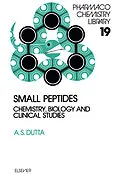Pharmacochemistry Library, Volume 19: Small Peptides: Chemistry, Biology, and Clinical Studies focuses on the processes, reactions, properties, and characteristics of peptides, including analogues and proteases.
The publication first takes a look at angiotensin II and bombesin/gastrin-releasing peptide. Topics include conformationally restricted analogues of bombesin, non-peptide antagonists of angiotensin II, receptor subtypes of angiotensin II, and bombesin/GRP antagonists and cancer. The text then elaborates on bradykinin, cholecystokinin, and enkephalin analogues.
The manuscript examines luteinizing hormone releasing hormone and somatostatin. Topics include enzymic degradation of somatostatin and analogues, clinical applications of somatostatin analogues, and pharmacological and clinical studies with LHRH agonists and antagonists. The formulation of peptides and inhibitors of aspartyl proteases are also mentioned.
The book is a valuable source of information for chemists, biologists, and readers interested in small peptides.
Inhalt
Acknowledgments
Introduction
Chapter 1 Angiotensin II
1. Introduction
2. Receptor Subtypes of Angiotensin II
3. Agonist Analogues of Angiotensin II
4. Peptide Antagonists of Angiotensin II
4.1. Modifications of the C-Terminal Phe Residue
4.2. Replacement of the Tyr4 Residue
4.3. N- or C-Terminal Deletions
4.4. Interchanging the Tyr4 and Phe8 Residues
5. Non-Peptide Antagonists of Angiotensin II
5.1. Modifications of the Early Imidazole Leads
5.2. Imidazole-5-Acrylic Acid Derivatives as Antagonists of Angiotensin II
5.3. Imidazo[4,5-b]pyhdine Derivatives as Antagonists of Angiotensin II
5.4. 2-Alkyl Benzimidazole Derivatives as Antagonists of Angiotensin II
5.5. 2-Alkyl-4-(Biphenyl)Methoxyquinoline and 2,6-Dialkyl-4-(Biphenyl)Methoxy Pyridine Derivatives as Antagonists of Angiotensin II
5.6. Naphthalene, Tetrahydronaphthalene, Bromoindole and Bromobenzofuran Derivatives as Antagonists of Angiotensin II
5.7. Angiotensin Antagonists Containing an Aminomethylene Bridge
6. Non-Peptide Antagonists of Angiotensin II Acting at the AT2 Receptor
7. Summary
8. References
Chapter 2 Bombesin/Gastrin-Releasing Peptide
1. Introduction
2. Antagonists of Bombesin/GRP
2.1 Deletion of the C-Terminal Methionine Residue or the Dipeptide Leucylmethionine
2.2 Modification of the Backbone Amide Groups
2.3 Amino Acid Substitutions in Position 12
2.4 Substance P Antagonists as Bombesin Antagonists
3. Conformationally Restricted Analogues of Bombesin
4. Bombesin/GRP Antagonists and Cancer
5. Summary
6. References
Chapter 3 Bradykinin Analogues
1. Introduction
2. Receptor Subtypes of Bradykinin
3. Agonist Analogues of Bradykinin
4. Antagonists of Bradykinin
4.1. B1 Receptor Antagonists
4.2. B1 and B2 Receptor Antagonists
5. Biological Profile of HOE 140 and Related Antagonists
5.1. In Vitro Studies
5.2. In Vivo Studies
6. Side Effects Associated with Bradykinin Antagonists
7. Summary
8. References
Chapter 4 Cholecystokinin Analogues
1. Introduction
2. Distribution and Biological Functions of Cholecystokinin
3. Cholecystokinin Receptor Subtypes and Receptor-Selective Ligands
3.1. CCK-A Receptor Ligands
3.2. CCK-B Receptor Ligands
4. Peptide Antagonists of Cholecystokinin and Gastrin
4.1. Cholecystokinin and Gastrin Antagonists Based on the CCK Sequence
4.2. Antagonists Based on the Gastrin C-Terminal Sequence
4.3. Antagonists Obtained by Peptide Bond Replacements
4.4. Antagonists Containing a Homo Amino Acid Residue
4.5. Other Approaches to Antagonists
5. Non-Peptide Antagonists of CCK and Gastrin
5.1. Amino Acid Derivatives as CCK and Gastrin Antagonists
5.2. Substituted Benzodiazepines as CCK and Gastrin Antagonists
5.3. 3-Substituted-1,4-Benzodiazepines as CCK Antagonists
5.4. CCK-A Receptor Ligands Based on Tifluadom
5.5. Hybrid CCK Antagonists Based on Lorglumide and L-364,718 (MK-329)
5.6. a-Methyltryptophan Derivatives as CCK Antagonists
5.7. Quinazolinone Derivatives as CCK-B Receptor Ligands
6. Summary
7. References
Chapter 5 Enkephalin Analogues
1. Introduction
2. Enzymic Inactivation of Enkephalins
3. Early Structure Activity Relationship Studies
4. Agonist Analogues Displaying Analgesic Activity
5. Analogues with Improved Selectivity for the µ and d Receptors
5.1. d-Selective Analogues
5.2. µ-Selective Analogues
6. Antagonists of Enkephalins
6.1. d-Selective Antagonists Based on the Enkephalin Sequence
6.2. µ-Selective Antagonists of Enkephalin
7. Summary
8 References
Chapter 6 Luteinising Hormone Releasing Hormone
1. Introduction
2. Enzymic Degradation of LHRH
3. Sar of LHRH Agonists
3.1 Biologically Active Analogues of LHRH Smaller than a Decapeptide
3.2 Potent Analogues of LHRH Incorporating Changes in Positions 6, 7 and 10
3.3 Potent Analogues of LHRH Incorporating a-Aza-Amino-Acid Residues
3.4 Potent Analogues of LHRH with Hydrophilic Residues in Position 6
3.5 Analogues of LHRH Containing Nitrogen Mustard Derivatives or Cytotoxic Metal Complexes
4. Sar of LHRH Antagonists
4.1 Summary of the Earlier Work
4.2 Recent Work on LHRH Antagonists
5. LHRH Antagonists and Histamine Release
6. Hexapeptide Derivatives as LHRH Antagonists
7. Ketaconazole Derivatives as LHRH Antagonists
8. Formulations of LHRH and the Analogues
9. Pharmacological and Clinical Studies with LHRH Agonists and Antagonists
9.1 Use of LHRH Agonists for the Treatment of Prostate Cancer
9.2 Use of LHRH Antagonists for the Treatment of Prostate Cancer
9.3 Use of LHRH Agonists for the Treatment of Breast Cancer
9.4 Use of LHRH Antagonists for the Treatment of Breast Cancer
9.5 Use of LHRH Agonists and Antagonists in Endomethosis
9.6 LHRH Agonists for the Treatment of Uterine Fibroids (Leiomyomata)
9.7 LHRH Agonists as Male Contraceptives
9.8 LHRH Antagonists as Male Contraceptives
9.9 LHRH Agonists as Female Contraceptives
9.10. LHRH Antagonists as Female Contraceptives
10. Summary
11. References
Chapter 7 Somatostatin
1. Introduction
2. Enzymic Degradation of Somatostatin and Analogues
3. Agonist Analogues of Somatostatin. Sar Studies
3.1 Role of the Disulphide Bridge and the N-Terminal Ala-Gly Residues
3.2 Effects of Single Amino Acid Substitutions on the Biological Activity of Somatostatin
3.3 Effects of N-Terminal Extension and Multiple Substitutions on the Biological Activity of Somatostatin
3.4 Cyclic Dodecapeptide Analogues with Amino Acid Deletions and Disulphide Bridge Modifications
3.5 Bicyclic Decapeptide and Cyc…
